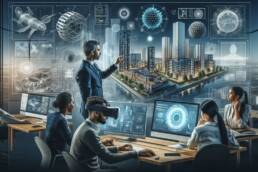The use of virtual reality is expanding across various industries, it is helpful to investigate the depths of related terminology and technology. The majority of individuals only have a fundamental understanding of virtual reality headgear and several popular VR applications, despite the advances. We have viewed videos 360 degrees.
An ongoing trend is virtual reality. Hardware development receives a lot of financing from major global technology companies. This indicates the interest and promises this new industry has attracted. Besides the leisure and video game industries, these technologies provide tools that can improve how and the environment in which we work in a range of fields, such as medicine, engineering, industry, construction, architecture, and culture. The development of ideas and technology that can improve these industries’ work processes has already begun.
This article’s major aim is to distinguish the difference between 3D and VR.
What is 3D?
The abbreviation 3D stands for three dimensions. It refers to a three-dimensional thing, in other words. The real world is a wonderful illustration of the format because it is 3D all the time. The production of 3D VR requires the same standard toolkit as that of Triple-A games. The process is pretty much like developing a 3D game.

What is Virtual Reality?
Virtual reality is the practice of using computer technology to simulate a real-world situation in a virtual environment (VR). Virtual reality’s most obvious component is the head-mounted display (HMD). The user can move around and interact with the environment in the fake, computer-generated world depending on the program. The majority of the time, this environment is navigated and operated with a controller and head movements.

Differences between Virtual Reality and 3D
We do have 3D viewing glasses, though. These are the glasses that are used in theatres so that we may view films that are projected in three dimensions. One of the best examples of this technology still allows us to sit and view a recorded video from the outside. But virtual reality creates a three-dimensional world that we can move about in and interact with using a range of much more advanced devices. To replicate that world, they must be connected to a powerful computer, but today there are already standalone devices with improving quality on the market. In essence, it’s the same as taking part in the movie’s environment at a 1:1 scale, like in real life.



